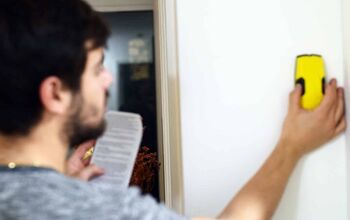How To Cover Exterior Cinderblock Walls (6 Ways To Do It!)

Cinderblock walls are a common part of many rugged structures, including sheds, garden areas, and as fencing around pools. However, they are not exactly the nicest thing to look at. That’s why most people who have cinderblock walls outside want to find a way to cover them. The question remains how do you cover these big, bulky walls?
Cover your cinderblock wall with bonding cement and smooth it out with a trowel. Let the cement dry and paint over the bonding cement to make it look better. You can also leave the bonding cement as it is if you want to create a natural stone look.
We’re not going to mince word. Cinderblocks are ugly. This article will help you get rid of this eyesore and make your exterior wall look a little better.
Do You Need Handyman Services?
Get free, zero-commitment quotes from pro contractors near you.

Covering Your Exterior Walls With Cement: The Step By Step Guide
If you want to make your life easier, choose to cover your exterior walls with cement. Here’s how to do it, plain and simple:
- Start by putting on your protective gear. Much like how you would do if you had to projects with another bag of concrete, you will need to don protective gloves, boots, and clothing. Cement, much like concrete, can burn you. So, make sure that you’re fully geared up.
- Grab a bag of surface bonding cement and mix it up. You can use a cement mixer, or a bucket and water. It’s up to you to determine which is right for you. To mix your cement properly, follow the instructions on the cement bag.
- Take a trowel and start applying the mixture to your cinderblock wall. When applying the mixture, use the trowel to smooth things out. Make sure that all parts of the cinderblocks are covered, not just the gaps between them.
- Let the cement dry, then paint the exterior of the wall with the paint of your choosing. Cement finishes are very paint-friendly, and even removing paint from cement is fairly easy. This makes this method of covering your walls with cement one of the easier ones to choose.
Covering Your Exterior Walls: Other Alternatives To Consider
While cement is the easiest option you can pick, it’s far from the only one. What you want to cover your cinderblock exterior with is all up to you, so we’re going to present some of the other options you can choose, as well as some brief information about the process. Since each of these processes tends to be more involved and better suited to pros, we’re not going to go into detail. (It’d make the article too long!)
Stucco Coverings
Stucco is such a hot material right now! This sandy cement-like material offers you the ability to add texture and color to your cinderblock walls. All you need to do is mix the stucco to your liking, adding the pigments you want along in it. Then, add a “scratch coat” that will let the stucco lock into your wall.
After the scratch coat is applied, you (or your contractors) will be able to put the final coats over it. Your final coats will be where you can add designs, additional color layers, and more. Fun, right? If your home has Spanish-style architecture, or if you want to add a bohemian touch to a garden shed, stucco is a good choice.
Vinyl Siding
Admittedly, vinyl siding is one of the best ways to make sure that you get the pristine, uniform appeal you want for your home. However, it’s also one of the more difficult things to install on your cinderblock. For one thing, you will need to nail in furring strips between the joints of the cinderblocks in order to make this even remotely possible.
Due to the difficulty of vinyl siding installation, you will need to call a professional for this. Even so, most people who have some cinderblock walls attached to their home agree that the high price tag is well worth it. If you have a particularly strict homeowner’s association or want to sell your home for the highest possible profit, vinyl siding probably is the way to go in most cases.
Stone
Some people choose to build small stone walls around the cinderblocks, using bonding cement, mortar, and grouting to get the stone to cling to the cinderblock. This option adds a nice rustic, almost classical ambiance to your building’s exterior and can also act as a perfect backdrop for a garden.
There are several different methods you can use to cover cinderblock walls with stone. If you have some experience with masonry, then this might be a good choice for a DIY project. On the other hand, inexperienced individuals may want to try to call a pro. Regardless of who installs it, stone is guaranteed to be one of the most rugged option.
Artificial Stone
An increasingly popular way to cover up cinderblock walls is to use artificial stone panels. These panels look like classic masonry, and often even feel like classic masonry. However, it’s generally easier to install than actual stone, not to mention a lot cheaper to buy. This makes it a great pick for people who don’t have a big budget and also want an easy “fix.”
Like with real stone, there are several different ways you can install artificial stone onto a cinderblock wall. The method you use will depend on how the artificial stone is made. It’s worth noting that some of these veneers might require you to add grouting on them after you’ve installed them since they don’t always stick well without it.
Au Naturel
If you are not a fan of going through all the work of covering your wall up with stone or other types of masonry, there’s another option that can work. Many people now use vines, gardening, and plants as a way to add a splash of natural color to your wall. However, there are several other drawbacks that you may need to be aware of if you choose this option.
Plants can eat away at the cinderblock’s stability, not to mention shift around as they grow. If you live in a cold climate, then the plants will probably die every winter, which will turn the entire setup into an eyesore. That’s why this method of wall covering is best left for outdoor purposes—like what you might want to do for a garden shed, a pool barrier, or something similar.
Do You Always Need To Cover Cinderblock Walls?
Here’s the thing about cinderblock walls that you need to understand: they’re pretty rugged in most situations. That’s why they are used in many different types of foundations, not to mention a wide range of projects that require sturdiness. While most people prefer to hide the fact that they look so industrial, there are moments where you might not have to cover those walls.
In many situations, the choice to cover those walls is primarily an aesthetic one. Unless the wall in question is part of your home, adding reinforcements and coverings isn’t really required. Even so, you might end up getting a write-up from the local HOA if you don’t cover up certain walls.
Do You Need Handyman Services?
Get free, zero-commitment quotes from pro contractors near you.

Related Questions
Can you put wood paneling on cinderblock walls?
Wood paneling is one of the most flexible materials that you can build with, and that means it can be installed on almost any wall type. This includes cinderblock walls. However, it’s worth noting that wood paneling is not always the most durable option out there. If you want to make sure that your wood paneling lasts, only use paneling on interior cinderblock walls.If you want to add wood to a cinderblock wall on the exterior of your home, you may want to try something a little different—such as a shiplap wall or a repurposed pallet wal l in front of the cinderblock.
Is it possible to insulate cinderblock?
While there are a lot of different ways to work around the issue, the truth is that you can’t really insulate cinderblock walls. The only real workaround that is effective is to cover the inside of the cinderblock walls. However, this is only so effective and it can be hard to balance the air temperature throughout the room.If you need to get more insulation, do not try to build a structure composed of cinderblock. It just won’t work well.
What’s the best way to strengthen cinderblocks?
Cinderblocks are already durable, but that doesn’t mean you shouldn’t want more strength. If you need to reinforce your cinderblock wall, pour concrete inside each of the cinderblocks. The additional concrete can help prevent damage from impacts, temperature fluctuations, and more.If you need even more reinforcement, you can also coat the exterior of your cinderblock wall with cement or double up on your wall’s thickness. Because cinderblock is so versatile, it’s easy to find ways to add some extra strength to your structure, regardless of what you do.
Related Guides

Ossiana Tepfenhart is an expert writer, focusing on interior design and general home tips. Writing is her life, and it's what she does best. Her interests include art and real estate investments.
More by Ossiana Tepfenhart



























